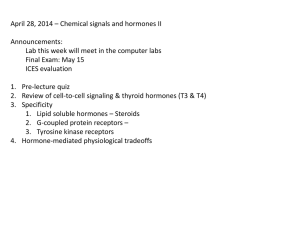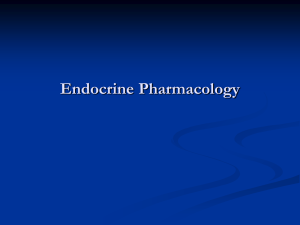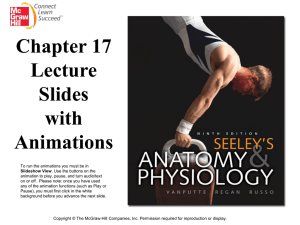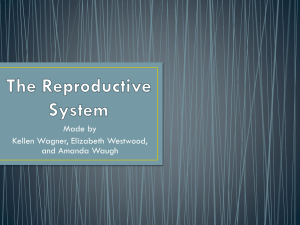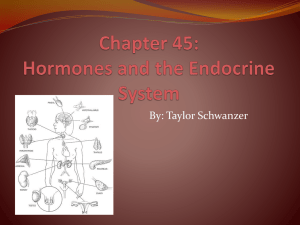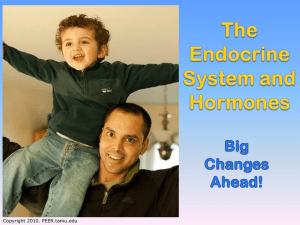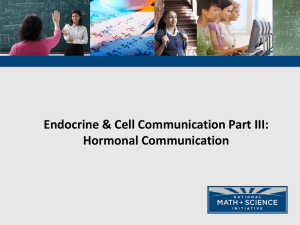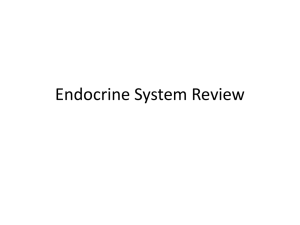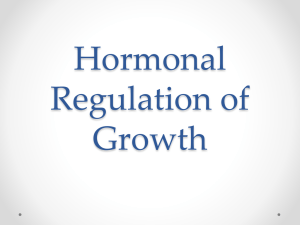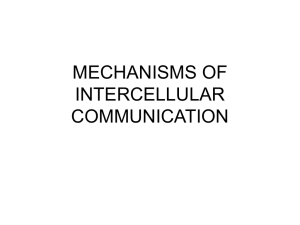Introduction to the Endocrine System
advertisement
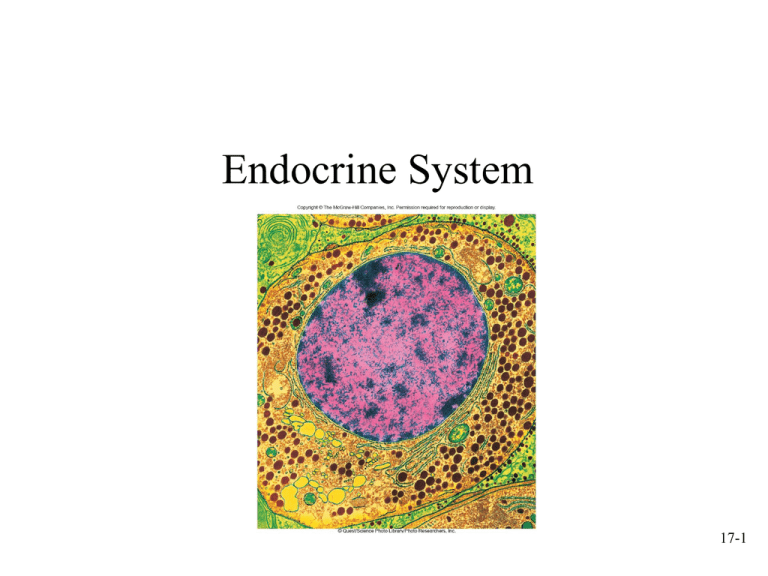
Endocrine System 17-1 I. Introduction to endocrine system • A. Classes of Chemical Messengers – 1. Autocrine chemical messengers: released by cells and have a local effect on same cell type from which chemical signals released; e.g., prostaglandin – 2. Paracrine chemical messengers: released by cells and affect other cell types locally without being transported in blood; e.g., somatostatin – 3. Neurotransmitter: produced by neurons and secreted into extracellular spaces by presynaptic nerve terminals; travels short distances; influences postsynaptic cells; e.g., acetylcholine. – 4. Endocrine chemical messengers: type of intercellular signal. Produced by cells of endocrine glands, enter circulatory system, and affect distant cells; e.g., estrogen 17-2 17-3 B. Characteristics of the Endocrine System • 1. Glands that secrete chemical messengers (hormones) into circulatory system • 2. Hormone characteristics – Produced in small quantities – Secreted into intercellular space – Transported some distance in circulatory system – Acts on target tissues elsewhere in body • 3. Regulate activities of body structures 17-4 C. Comparison of Nervous and Endocrine Systems • Similarities 1. Both systems associated with the brain • Hypothalamus • Epithalamus 2. May use same chemical messenger as neurotransmitter and hormone. • Epinephrine 3. Two systems are cooperative • Nervous system secretes neuroendocrine peptides, or neurohormones, into circulatory system • Some parts of endocrine system innervated directly by nervous system 17-5 Differences 1. Mode of transport – Axon – Blood 2. Speed of response – Nervous – instant/milliseconds – Endocrine – delayed/seconds 3. Duration of response – Nervous – milliseconds/seconds – Endocrine – minutes/days 4. Amplitude vs. frequency 17-6 II. General characteristics of hormones A. Stability • 1. Half-life: The length of time it takes for half a dose of substance to be eliminated from circulatory system 2. Long half-life: regulate activities that remain at a constant rate through time. Usually lipid soluble and travel in plasma attached to proteins 3. Short half-life: water-soluble hormones as proteins, epinephrine, norepinephrine. Have a rapid onset and short duration B. Communication • 1. Interaction with target cell • 2. Lipid soluble hormones pass through cell membrane and usually travel to nucleus • 3. Water soluble hormones generally attach to a receptor site on cell membrane C. Distribution • 1. Hormones dissolve in blood plasma and are transported in unbound or are reversibly bound to plasma proteins. • 2. Hormones are distributed quickly because they circulate in the blood. 17-7 • D. Lipid soluble hormones • 1. must connect to binding proteins in blood or would be catabolized quickly • 2. long half lives as they are protected • 3. tend to have more constant blood levels and regulate basal activity • 3. the liver can attach water soluble radicals to these enzymes so that the kidneys can excrete the hormone 17-8 • 4. process called conjugation • E. Water soluble hormones • 1. travel freely in circulatory system • 2. larger and don’t diffuse through membranes easily • 3. fenestrated target tissues • 4. short half lives due to proteases circulating in blood • 5. concentrations tend to change rapidly and they regulate activities with rapid onset and short duration 17-9 17-10 17-11 III. Patterns of Hormone Secretion • A. Chronic hormone regulation. 1. Maintenance of relatively constant concentration of hormone. Thyroid hormone. • B. Acute hormone regulation. Epinephrine in response to stress. • C. Episodic (Cyclic) hormone regulation. Female reproductive hormones. 17-12 IV. Control of Hormone Secretion • • • • • Most hormones controlled by negative feedback systems In negative feedback, the eventual product turns off the sensor which initiated the products synthesis-self limiting Common example is the heating of your house In positive feedback, the product stimulates the sensor to increase its own production-self propagating Most hormones are not secreted at constant rate, but their secretion is stimulated by three different methods 1. The action of a substance other than a hormone on an endocrine gland-humoral control-pth and Ca ion 2. Neural control of endocrine gland-ie adrenal cortex 3. Control of secretory activity of one endocrine gland by hormone or neurohormone secreted by another endocrine gland-pituitary gland and thyroid 17-13 Control by Humoral Stimuli 17-14 Control by Neural Stimuli 17-15 Control by Hormonal Stimuli 17-16 17.4 Hormone Receptors and Mechanisms of Action 17-17 V. Target Tissue Specificity and Response • A. Portion of molecule where hormone binds is called binding site. • B. If the molecule is a receptor (like in a cell membrane) the binding site is called a receptor site • C. hormone/receptor site is specific; e.g., epinephrine cannot bind to the receptor site for insulin. • D. The purpose of binding to target tissue is to elicit a response by the target cell. • E. Diagram shows what happens with larger water soluble hormone which binds to a receptor on the membrane surface 17-18 F. Changes in Receptor Number • 1. Normally, receptor molecules are degraded and replaced on a regular basis. • 2. Down-regulation – Rate at which receptors are synthesized decreases in some cells after the cells are exposed to a hormone. – Combination of hormones and receptors can increase the rate at which receptor molecules are degraded. This combined form is taken into the cell by phagocytosis and then broken down. – Explains the desensitization that can occur to some drugs 17-19 3. Increase in Receptor Number- Up regulation – Some stimulus causes increase in synthesis of receptors for a hormone, thus increases sensitivity to that hormone – For example, FSH stimulation of the ovary causes an increase of LH receptors. – Prepares the ovarian cells’ membranes to prepare for the LH surge that stimulates ovulation 17-20 VI. Classes of Receptors A. Lipid soluble hormones • 1. Lipid-soluble hormones bind to nuclear receptors • 2. Lipid soluble hormones are relatively small molecules; pass through the plasma membrane • 3. React either with enzymes in the cytoplasm or with DNA to cause transcription and translation • 4. Examples include thyroid hormones, testosterone, estrogen, progesterone, aldosterone, and cortisol • 5. because of transcription and translation processes, there is a lag time between hormone binding and having its effect exerted 17-21 B. Water-soluble hormones • 1. Water-soluble hormones bind to membrane-bound receptors • 2. integral proteins with receptor site at extracellular surface. • 3. Interact with hormones that cannot pass through the plasma membrane. • 4. Attachment of hormone causes intracellular reaction • 5. often binding of hormone causes the production of a second molecule that activates existing internal systems • 6. adrenalin acts this way • 7. faster acting and shorter lived affects when compared to lipid soluble hormones 17-22 17-23 Action of Nuclear Receptors • Proteins in cytoplasm or nucleus • Hormones bind with intracellular receptor and receptor-hormone complex activate certain genes, causes transcription of mRNA and translation. These proteins (enzymes) produce the response of the target cell to the hormone • Latent period of several hours because time is required to produce mRNA and protein • Processes limited by breakdown of receptorhormone complex • Estrogen and testosterone produce different proteins in cells that cause the differing secondary sexual characteristics of females and males. 17-24 17-25 Membrane-Bound Receptors •Intracellular mediators: ions or molecules that enter cell or are produced in cell •Can be produced because of G protein activation •Regulate intracellular enzyme activities 17-26 17-27 Insert table 17.5 17-28 Receptors that Activate G Proteins 17-29 G Proteins that open Calcium ion Channels 17-30 G Proteins that Interact with Adenylate Cyclase 17-31 G Proteins that Interact with other Intercellular Mediators 17-32 Receptors That Directly Alter the Activity of Intracellular Mediator 17-33 Receptors That Phosphorylate Intracellular Proteins • Hormones bind to membrane-bound receptors. • Part of receptor protein on inside of membrane acts as an enzyme to phosphorylate proteins • E.g., insulin receptors bound to insulin cause phosphorylation of proteins and cell responds to presence of insulin. 17-34 Signal Amplification 17-35 17-36
